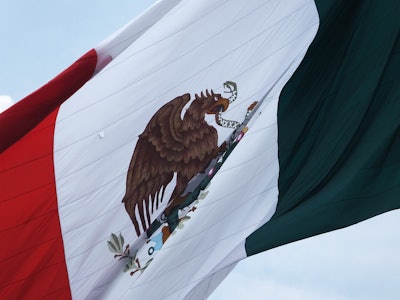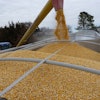
The 2016/2017 marketing year set a new record for U.S. exports of feed grains in all forms (GIAF) with 114 million metric tons sold, based on figures provided by the U.S. Department of Agriculture (USDA) and analyzed by the U.S. Grains Council (USGC). With prices at or below cost of production combined with four consecutive years of large harvests, the Council has focused on engaging with markets around the world to seize opportunities for global market growth, building demand to support U.S. farmers and agribusiness now and in the future.
The 12% increase in U.S. GIAF exports reflects the shifting dynamics in world markets and global trade policies as well as the current price environment. The diversification in world buyers reflects increased continued interest from traditional customers, trade policy troubles in select markets and new buyers emerging from developing countries.
While the value of these exports does not match the record set in quantity, these marketing opportunities are representative of the Council’s work to support U.S. agricultural producers by building a global outreach program that can capture shortterm market opportunities and long-term demand for the bushels of grain they harvest as well as co-products like distiller’s dried grains with solubles (DDGS) and ethanol.
The Council diligently works to stay ahead of market shifts for exports of U.S. corn, sorghum, barley, ethanol, DDGS, corn gluten feed/meal and other co-products. The Council also evaluates feed grains in all forms holistically including the corn equivalent of beef, pork and poultry meat exports — to better capture how much of U.S. feed grain production is actually used in the world market.
U.S. exports most corn in more than a decade
In the 2016/2017 marketing year (September-August), U.S. corn exports realized substantial gains with the most exports since 2007/2008, 58.1 million tons (2.29 billion bushels) purchased by 72 overseas buyers in 2016/2017. The 21% increase year-over-year represents the most corn sold since 1989/1990.
Export sales of U.S. corn to the Western Hemisphere set a new record, increasing almost 7% year-over-year to nearly 28.7 million tons (about 1.13 billion bushels).
Mexico maintained its rank as the largest buyer of U.S. corn, and for the fourth year in a row, set a new record at 13.9 million tons (547 million bushels). Thanks to the successful trading relationships developed under the North American Free Trade Agreement (NAFTA), the integrated supply chain for livestock production in Mexico continues to reap benefits for U.S. corn producers through sales to this top customer.

进一步的南部,其他自由贸易协定伙伴also snagged top export customer spots. Since the U.S.-Colombia Trade Promotion Agreement entered into force in May 2012, corn exports to Colombia have set a new record every subsequent year, culminating with 4.73 million tons (186 million bushels) in imports in 2016/2017. And exports to the fifth largest buyer, Peru, totaled almost 2.99 million tons (nearly118 million bushels), thanks in large part to the preferential trading terms laid out in the United States-Peru Free Trade Agreement.
横跨太平洋,日本进口增加nearly 30% year-over-year to 13.5 million tons (nearly 533 million bushels), the highest levels since 2009/2010 and the second largest market for U.S. corn. South Korea set a six-year high for U.S. corn imports at 5.6 million tons (220 million bushels), jumping to the third largest buyer of U.S. corn. And corn exports to Taiwan hit the highest levels in seven years at 2.94 million tons (116 million bushels).
The combination of market access provided by the 20 free trade agreements the United States has signed, pricing and trusted relationships built over more than five decades of work by the Council resulted in this year’s marketing year success. The Council continues to work to capture even more demand for U.S. corn by emphasizing the economic, logistic and value advantages of the feed grain to both the most loyal and large markets and short-term opportunities markets where they arise.

Ethanol exports climb even higher
The Council has strategically focused on promoting the United States as a reliable and affordable source of ethanol, conveying the economic, environmental and human-health advantages of using ethanol as fuel octane. Global markets are responding to this engagement, with record-setting U.S. ethanol exports of 1.37 billion gallons (488 million bushels in corn equivalent) exported to 76 countries in 2016/2017, a 34% increase year-over-year.
Brazil was the year’s top buyer, setting a new export record with 499 million gallons (178 million bushels in corn equivalent) in purchases. While Brazil will continue to be one of the fastest growing ethanol markets, U.S. exports will not be able to fairly compete due to a new government policy instituted on Sept. 1, 2017 that applies a 20% tariff to all imports of ethanol after a 600-million-liter (158.5 million gallon) tariff rate quota (TRQ).
Other top customers with open policies continue to import U.S. ethanol in large quantities. Canada imports close to 20% of domestic fuel ethanol, nearly all of it from the United States. As a result, Canada ranked as the second largest buyer of U.S. ethanol in 2016/2017 with 332 million gallons (119 million bushels in corn equivalent).
And new market potential exists throughout the world marketplace. Purchases of U.S. ethanol by buyers in the Middle East/Africa region jumped more than 68% year-over-year to 89.2 million gallons (32 million bushels in corn equivalent). Leading the increase, the United Arab Emirates upped imports of U.S. ethanol to 45.5 million gallons (16.2 million bushels in corn equivalent) in purchases, representing the sixth largest market for U.S. ethanol, compared to nearly 13.2 million gallons (4.7 million bushels in corn equivalent) the year prior.
The Council continues to engage with governments and industries to best meet the needs of the growing and shifting market for U.S. ethanol. In October, the Council conducted the Ethanol Summit of the Americas in collaboration with Growth Energy, the Renewable Fuels Association and the Iowa Corn Promotion Board. The event brought together industry and government officials from more than 15 countries in the Western Hemisphere to enliven discussions of global ethanol use and launch expanded regional engagements.
DDGS markets stay steady
Adverse trade policy decisions by the historic top two buyers — China and Vietnam — caused a significant drop in purchasing of U.S. DDGS in 2016/2017. However, U.S. DDGS exports of nearly 11.1 million tons stayed steady with the previous marketing year and above the previous five-year average of 10.2 million tons.
China purchased 739,000 tons of U.S. DDGS, down 78% year-over-year, still the fifth largest market. These purchases occurred prior to the Chinese government subjecting U.S. DDGS to antidumping and countervailing duties that restricted access to the market. Vietnam purchased 50% less U.S. DDGS at nearly 495,000 tons, compared to almost 986,000 metric tons the prior year. Market potential is more optimistic in the new marketing year as the Vietnamese government lifted its suspension of U.S. DDGS imports in September 2017.
Offsetting the decline in sales to these two countries, the global market for U.S. DDGS diversified significantly with 54 countries purchasing the ethanol co-product, compared to 37 countries 10 years ago. Numerous customers increased purchases including Mexico, Turkey, South Korea, Canada and even New Zealand.
Exports of DDGS and corn gluten feed/meal to the Western Hemisphere increased 12% year-over-year, the most purchases since 2010/2011. Mexico was the top buyer of U.S. DDGS with 2.06 million tons. The Council is continuing to expand efforts to promote feeding of DDGS into more regions in Mexico, which is paying off thanks to favorable trading terms under NAFTA and available supply.
U.S. DDGS and corn gluten feed/meal exports to the Middle East/Africa also set a new export high, jumping 54% from the record set in 2015/2016. Turkey drove the increase, nearly doubling purchases of U.S. DDGS to 1.36 million tons, ranking as the second largest buyer in the marketing year. The Council has focused on working with Turkey’s major feed importing countries throughout the last two years to capitalize on the demand opportunities driven by increased demand for meat, dairy and poultry products in Turkey.
Longer-term market development work is paying off with DDGS sales to South Korea, the third largest buyer for the marketing year. South Korea set a new record for imports at 979,000 tons. In fact, for the last 15 years, South Korea has steadily increased imports of U.S. DDGS, setting a new high each year since 2011/2012.
Ninety-six percent of feed millers in South Korea now include U.S. DDGS in their rations for the country’s livestock and poultry industries, thanks in part to work started by the Council in 2004 to introduce this feed ingredient. Now the Council is working to increase average inclusion rates by providing additional technical expertise.
The Council helped to introduce U.S. DDGS to the world as a feed grain co-product chock- full of nutritional and economic advantages. The downward shift in DDGS prices was challenging for U.S. producers and agribusinesses in 2016/2017, but a diverse market development program has helped transform short-term opportunities in countries like New Zealand and Saudi Arabia into larger markets that set their own records.
Work continues in new marketing year
Engagement that meets the needs of long-standing trading partners and opportunistic buyers combined with attractive prices have allowed U.S. feed grains and co-products to move into markets old and new during the 2016/2017 marketing year. As the new marketing year continues to develop, this work on market access, technical education and trade servicing will become increasingly important to secure U.S. market share.
委员会已经在努力捍卫和expand market share in a highly competitive world marketplace. The Council continues to actively share information with end users on crop conditions, quality and production in order to keep long-term, loyal customers and capitalize short-term market opportunities. The rollout of the Council’s corn harvest quality reports this fall are a part of this continuous cycle to provide customers with the best information available at all times.
As overseas customers far and wide rely on the Council for this valuable insight, the Council too is reliant on the commitment of U.S. farmers and agribusiness to continue producing a consistent, quality supply of U.S. feed grains and co-products. Together, we all will continue to develop markets, enable trade and improve lives across the globe. ❚

Tom Sleight serves as the president and chief executive officer (CEO) of the U.S. Grains Council, The U.S. Grains Council develops export markets for U.S. barley, corn, sorghum and related products including distiller’s dried grains with solubles (DDGS) and ethanol. Working in 10 overseas offices and with 30 in-country representatives, the Council operates programs in more than 50 countries and the European Union. More about the Council and its programs is online atwww.grains.org.





















